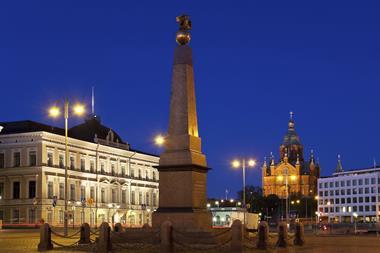It is said that timing is everything. Whether this is true or not it is certain that it is an extremely
important factor when it comes to property investment. The eternal debate that all investors have is whether the timing is right both for the entry and the exit of markets and assets. For many, however, the question is not necessarily one of whether the timing is right or wrong, as the global weight of money and requirement to invest does not allow the luxury of playing a purely cyclical game, but one of whether the timing is acceptable and what other factors are there that can reduce the impact that timing has on an investment.
Market size, economic strength and market
transparency are other aspects that help define
markets for investors. Put simply, the bigger the
market, the stronger the economy, and the more
transparent the market the more attractive it is to investors. This attraction added to a deep market makes for liquidity and liquidity is one of the key
features that helps smooth out inevitable bumps in a market.
It is liquidity that allows easy access to product and that enables exit strategies to be put into place. The absence of liquidity has caused some of the larger and more rapid movements in asset prices that the property markets have witnessed. Paris, I would argue, is a city that offers all of these positive
attributes, which is why it is the most popular continental market.
In 2004, property investment in the Ile de France (IDF) reached €10.32bn (a 21% increase compared with 2003), its highest level seen since 1998. Some 90% of the investment was in the office sector, with more than 4% in retail. The office market accounted for €9.28bn – 33% invested in Paris, almost 43% in the Western Business District (including la Défense) and 25% in the suburbs.
Retail in Paris has enjoyed rapid growth in
cross-border investment. Fund managers that have been very active in the office market have become more involved in the retail sector over the past few years, as have a number of other institutional and
private investors. In 2004, the volume of retail
investment in IDF reached €458mn, almost 8%
of total retail investment in continental Europe.
Of the total retail investment, 50% was invested
in Paris and 50% between the inner and outer
suburbs.
With a total of 45m/m2 of floor space, the IDF office market is the world’s second-largest after New York. While the IDF retail market contains 28% of the total retail space in France, a comparatively high concentration; by comparison Madrid accounts for only 19% of Spain’s retail space.
Over and above the strong investment characteristics of the market, Paris and the IDF also
benefit from a strong and diversified economic platform. Of the four largest Euro-zone economies, France currently offers the most attractive environment. France’s economy is the second-largest in the Euro-zone with the second-largest population of 62m. Paris is a major engine for the French economy; the IDF’s economy represents about 29% of France’s gross domestic product. The region’s economy is diversified so that no single sector of the economy has a disproportionate impact on GDP growth (as opposed to Frankfurt for example, which is heavily weighted towards banking and finance); this softens the impact of a weak economic cycle on the property market.
Consumer spending has historically been above annual GDP growth. This provides a positive environment for retail property particularly when the relative wealth of the IDF is taken into account; consumer spending per capita in the IDF is at €17,000pa – 20% higher than the national level. When it is considered that the population of the region is 11m (19% of the national population) it is straightforward to deduce that the economic fundamentals that drive retail property are very strong.
Factors in the IDF which support stable consumer spending include low household debt and a high
savings rate ratio, which reduce the risk of curtailment of spending during a future economic slowdown. This strength has led to the demand for increased space from international brands, and the tenant activity has pushed up prime rental levels across the sector in high streets, shopping centres and retail warehouses.
Retail investment has become increasingly competitive, with the solid income returns catching the eye of increasing numbers of investors. Looking at the IPD outputs, the retail sector has been one of
the star performers in the French property market for the past six years. The security of tenure in France keeps rents below market levels, increasing cashflow security and suggesting a potential
mispricing scenario.
The demographics of the region also influence the office sector. Almost 69% of the population of the IDF is of working age (20 to 59). This is 3% higher than the national level. Paris is unquestionably the region with the highest proportion of highly skilled employees (16% against 8% at the national level). The quality of the labour pool is a real incentive for big companies to locate in the IDF and therefore a driver for its office market. The market is also
underpinned by fact that most of the country’s state bodies and international companies are located in Paris, all providing relatively stable demand in the office market.
Since the economic downturn in 2000 the Paris office market has been more resilient than
most in Europe. The Paris market has only
experienced a modest fall in rental values compared with other European cities. Moreover, this has
been more due to a downward correction from
the peak levels of 2001 (+40%) than a sign of
fundamental problems. In 2004, take-up reached 1,906,000 m2, a 13% increase over 2003.
It is true to say that the improvement in demand was mainly due to the continuing fall in rents, especially in well-established locations, rather than because of the economy driving employment upawards.
A notable highlight in the market was the huge in pre-letting transactions, which stand at almost 300,000m2 following several mergers. The
vacancy rate is 6.6% – one of the lowest in Europe
(it is 8.1% in London’s West End and 9.20% in Madrid).
It has been a curious time in the office market over the last few years, with yields falling despite weakness in the underlying occupier markets. This has prevented asset values from falling which, logically, they could have done.
Of real interest is the type of assets that have been driving investment volumes; typically the key
transactions have been for properties that demonstrate long, secure income streams which should be able to ride out temporary weakness in the letting market. High-yielding stock has also been actively sought as the spreads between interest rates and yields allows a vacancy risk to be carried while impressive returns are generated through clever use of leverage.
In 2004 property experienced a very healthy
level of investment activity, with several
major deals, although the levels seen at the peak of the market in 1999 have not yet been regained. Investor confidence stems from the market having shown good resilience during the economic slowdown giving the expectation of stable returns and sustainable growth
Likewise the industrial sector has seen a number of new entrants into the market. Here yields of
over 8.5% have pulled in not only specialists who can see an advantageous yield compared with those in other European markets but also financially driven investors who can gear up acquisitions on the back of cheap borrowing rates.
Any marked improvement in the French economy should feed through to occupier demand which, it should be noted, has already shown signs of
improvement, with a higher level of demand in 2004 compared with 2003.
Given that vacancy rates are still some way below historic highs and that development is limited, a steady rise in rents can be envisaged. It should be understood that the restrictive planning policy in France is yet another element that underpins the
market, since regulated supply upholds both capital and rental values and helps prevent rapid unbalances occurring.
One likely result of an improving economy in the medium term, aside from a better rental market, will be an upward shift in interest rates and potentially an upward shift in yields. Our five-year view is that yields will on average move upwards by 0.25%, although they may dip further in the short term. The movement will differ according to asset quality but our belief is that low-yield core assets will move least and higher yielding assets will move most as yield compression unwinds.
The Paris market would therefore appear to offer something for everyone – high yielding industrial opportunities where high gearing may produce
good short-term returns, medium-term opportunities in office sector, for those who are willing to take
some letting risk, longer-term stability for
low-leveraged buyers of core assets that offer stable income streams both in the office sector and in the retail sector, where low household debt and a high savings rate will continue to support consumer spending.
The timing might not be perfect, but all things considered investing in Paris appears attractive today.
James Raynor is fund management director, and Béatrice Guedj is a research analyst at Grosvenor Continental Europe
































No comments yet